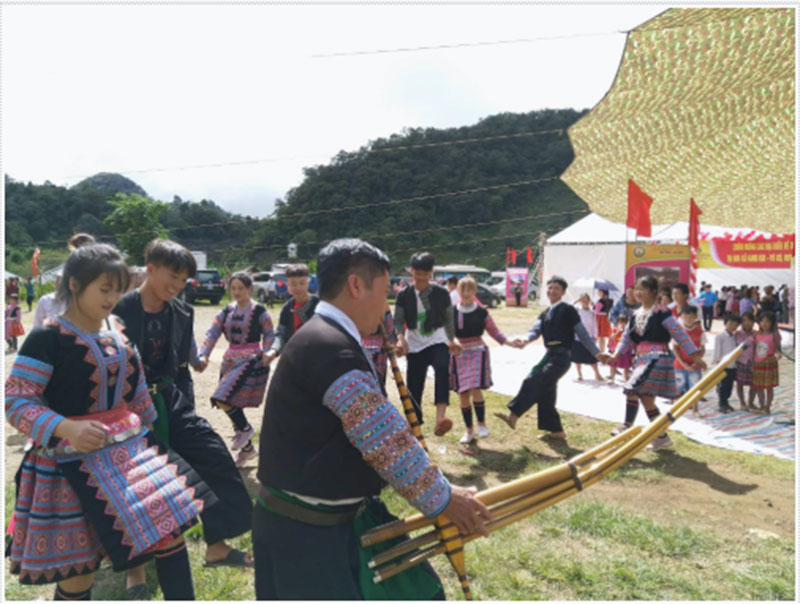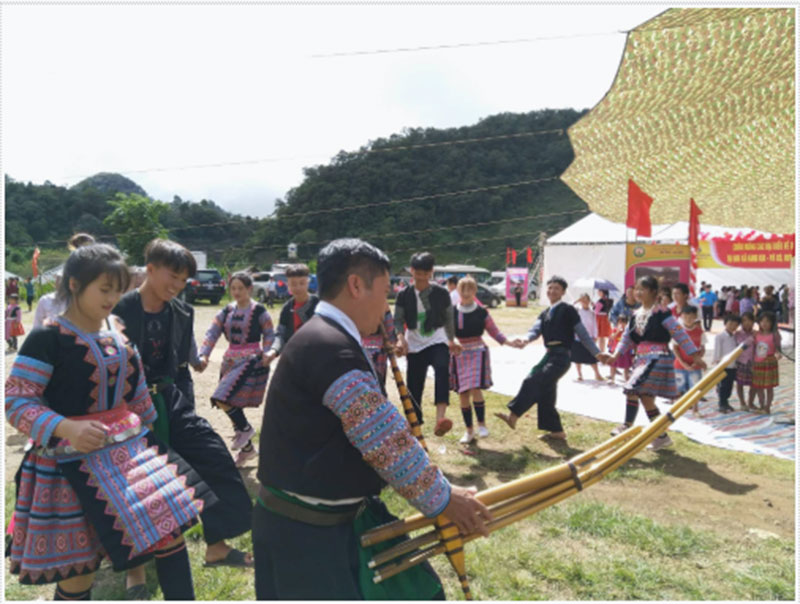
(HBO) - The mass culture in Pa Co commune is increasingly developing, attracting a large number of people to participate in the neighborhood art teams. Currently, the whole commune has 7 performance teams, each team has 15-20 members.
The cultural teams of the commune have built their operation regulations, self-shopping costumes and equipment to perform on holidays, New Year, the country's great anniversary.
Ms. Sung Y Hanh, a member of the Tra Day neighborhood art team, shared: The neighborhood music team was formed with nearly 20 members. We practice, preserve, promote the traditional cultural values of the nation and serve tourists.
 A special feature of the mass music movement here is that it still retains most of the traditional dances and folk songs of the Mong people.
A special feature of the mass music movement here is that it still retains most of the traditional dances and folk songs of the Mong people.
The development of popular arts enriches the spiritual life of the local people. The music performances were mainly staged by the members themselves with various forms of creativity, mainstreaming the propaganda and guidelines of the Party, policies, laws of the State, and contents of the movement "All people unite to build cultural life, "new countryside...
Mr. Sung A Bo said: The promotion of building a public performance team contributes information to the Party and State's guidelines and policies; preserves and promotes cultural values to the people. Through performing arts activities, the quality of art teams is increasingly improved. Thereby, contributing to the successful implementation of local political duties, improving the enjoyment of cultural life for people, eliminating customs and social evils.
With an increasingly vibrant and widespread emulation movement aimed at building cultured residential areas and cultured families, Yen Thuy District has been making steady progress toward improving both the material and spiritual well-being of its people, while fostering a civilized, prosperous, beautiful, and progressive community.
Once lacking recreational spaces and community facilities, Residential Group 2 in Quynh Lam Ward (Hoa Binh City) has recently received attention for the construction of a new, spacious, and fully equipped cultural house. The project followed the model of state support combined with public contributions in both labor and funding.
The "All people unite to build cultural life" movement, which has been effectively integrated with Kim Boi district’s socio-economic development goals, is fostering a lively spirit of emulation across local residential areas, hamlets, villages, public agencies, and enterprises. In addition, through the initiative, traditional cultural values are being preserved and promoted, while community solidarity and mutual support in poverty reduction and economic development are being strengthened.
A working delegation of the Hoa Binh provincial People’s Committee led by its Permanent Vice Chairman Nguyen Van Toan on June 11 inspected the progress of a project to build the Mo Muong Cultural Heritage Conservation Space linked to tourism services in Hop Phong commune, Cao Phong district.
Born and growing in the heroic land of Muong Dong, Dinh Thi Kieu Dung, a resident in Bo town of Kim Boi district, in her childhood was nurtured by the sweet lullabies of her grandmother and mother. These melodies deeply imprinted on her soul, becoming an inseparable part of her love for her ethnic group's culture. For over 20 years, this love for her hometown has driven Dung to research, collect, and pass down the cultural values of the Muong people to future generations.
In the final days of May, the Ethnic Art Troupe of Hoa Binh Province organized performances to serve the people in remote, mountainous, and particularly disadvantaged areas within the province. These were not just ordinary artistic shows, but they were the meaningful journeys aimed at spreading cultural values, enhancing the spiritual life of the people and contributing to the preservation of ethnic minority cultural identities.



 A special feature of the mass music movement here is that it still retains most of the traditional dances and folk songs of the Mong people.
A special feature of the mass music movement here is that it still retains most of the traditional dances and folk songs of the Mong people.